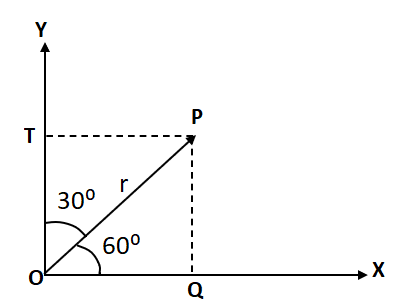
A displacement vector, at an angle of 30∘ with y-axis has a x-component of 10 units. Then the magnitude of the vector is?
A. 5.0
B. 10
C. 11.5
D. 20
Answer
216.3k+ views
Hint:Displacement vectors have both magnitude and direction. In the figure displacement vector is represented graphically with an arrow which gives the direction. To find the magnitude of the displacement vector we only find the length of this vector. To get the magnitude of the displacement vector in two dimensions is represented as the resultant vector. We can simply measure the magnitude or length of the displacement vector by using the Pythagorean theorem.
Formula used:
Using trigonometric Ratios
\[\cos \theta = \dfrac{\text{Base}}{\text{Perpendicular}}\]
Where \[\theta \] is an angle between base and perpendicular.
Complete step by step solution:
x-component = 10 units
Displacement vector making angle to y-axis =\[{30^0}\]
Also, displacement vector making angle to x-axis
As \[\Delta \] PPQ is a right angled triangle,
\[\begin{array}{l}\angle POQ = {90^0} - {30^0}{\rm{ }} = {60^0}\end{array}\]
Let the displacement vector be \[\vec r\] making an angle \[\theta \] with the x-axis.

In right angled triangle POQ, we get
\[\cos {60^0} = \dfrac{{10}}{r}\]
As we know \[\cos {60^0} = \dfrac{1}{2}\]
By substituting this value,
\[\dfrac{1}{2} = \dfrac{{10}}{r}\]
\[\therefore r = 20\]
Therefore the magnitude of the displacement vector, r is 20 units.
Hence option D is the correct answer.
Note: The displacement vector from one point to another is defined as an arrow with its tail at the first point and its tip at the second. The magnitude or the length of the displacement vector is defined as the distance between the points. It is represented by the length of the arrow. The direction of the arrow gives the direction of the displacement vector.
Formula used:
Using trigonometric Ratios
\[\cos \theta = \dfrac{\text{Base}}{\text{Perpendicular}}\]
Where \[\theta \] is an angle between base and perpendicular.
Complete step by step solution:
x-component = 10 units
Displacement vector making angle to y-axis =\[{30^0}\]
Also, displacement vector making angle to x-axis
As \[\Delta \] PPQ is a right angled triangle,
\[\begin{array}{l}\angle POQ = {90^0} - {30^0}{\rm{ }} = {60^0}\end{array}\]
Let the displacement vector be \[\vec r\] making an angle \[\theta \] with the x-axis.

In right angled triangle POQ, we get
\[\cos {60^0} = \dfrac{{10}}{r}\]
As we know \[\cos {60^0} = \dfrac{1}{2}\]
By substituting this value,
\[\dfrac{1}{2} = \dfrac{{10}}{r}\]
\[\therefore r = 20\]
Therefore the magnitude of the displacement vector, r is 20 units.
Hence option D is the correct answer.
Note: The displacement vector from one point to another is defined as an arrow with its tail at the first point and its tip at the second. The magnitude or the length of the displacement vector is defined as the distance between the points. It is represented by the length of the arrow. The direction of the arrow gives the direction of the displacement vector.
Recently Updated Pages
JEE Atomic Structure and Chemical Bonding important Concepts and Tips

JEE Amino Acids and Peptides Important Concepts and Tips for Exam Preparation

Electricity and Magnetism Explained: Key Concepts & Applications

Chemical Properties of Hydrogen - Important Concepts for JEE Exam Preparation

JEE Energetics Important Concepts and Tips for Exam Preparation

JEE Isolation, Preparation and Properties of Non-metals Important Concepts and Tips for Exam Preparation

Trending doubts
JEE Main 2026: Application Form Open, Exam Dates, Syllabus, Eligibility & Question Papers

Derivation of Equation of Trajectory Explained for Students

Hybridisation in Chemistry – Concept, Types & Applications

Understanding the Angle of Deviation in a Prism

Understanding Collisions: Types and Examples for Students

How to Convert a Galvanometer into an Ammeter or Voltmeter

Other Pages
JEE Advanced Marks vs Ranks 2025: Understanding Category-wise Qualifying Marks and Previous Year Cut-offs

Units And Measurements Class 11 Physics Chapter 1 CBSE Notes - 2025-26

NCERT Solutions For Class 11 Physics Chapter 8 Mechanical Properties Of Solids

Motion in a Straight Line Class 11 Physics Chapter 2 CBSE Notes - 2025-26

NCERT Solutions for Class 11 Physics Chapter 7 Gravitation 2025-26

Understanding Atomic Structure for Beginners




